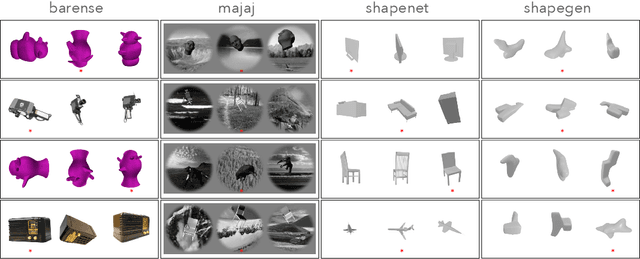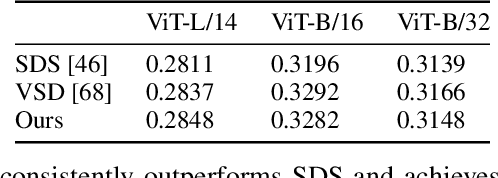Alexei A. Efros
MultiGen: Using Multimodal Generation in Simulation to Learn Multimodal Policies in Real
Jul 03, 2025Abstract:Robots must integrate multiple sensory modalities to act effectively in the real world. Yet, learning such multimodal policies at scale remains challenging. Simulation offers a viable solution, but while vision has benefited from high-fidelity simulators, other modalities (e.g. sound) can be notoriously difficult to simulate. As a result, sim-to-real transfer has succeeded primarily in vision-based tasks, with multimodal transfer still largely unrealized. In this work, we tackle these challenges by introducing MultiGen, a framework that integrates large-scale generative models into traditional physics simulators, enabling multisensory simulation. We showcase our framework on the dynamic task of robot pouring, which inherently relies on multimodal feedback. By synthesizing realistic audio conditioned on simulation video, our method enables training on rich audiovisual trajectories -- without any real robot data. We demonstrate effective zero-shot transfer to real-world pouring with novel containers and liquids, highlighting the potential of generative modeling to both simulate hard-to-model modalities and close the multimodal sim-to-real gap.
Visual Jenga: Discovering Object Dependencies via Counterfactual Inpainting
Mar 27, 2025Abstract:This paper proposes a novel scene understanding task called Visual Jenga. Drawing inspiration from the game Jenga, the proposed task involves progressively removing objects from a single image until only the background remains. Just as Jenga players must understand structural dependencies to maintain tower stability, our task reveals the intrinsic relationships between scene elements by systematically exploring which objects can be removed while preserving scene coherence in both physical and geometric sense. As a starting point for tackling the Visual Jenga task, we propose a simple, data-driven, training-free approach that is surprisingly effective on a range of real-world images. The principle behind our approach is to utilize the asymmetry in the pairwise relationships between objects within a scene and employ a large inpainting model to generate a set of counterfactuals to quantify the asymmetry.
GPS as a Control Signal for Image Generation
Jan 21, 2025Abstract:We show that the GPS tags contained in photo metadata provide a useful control signal for image generation. We train GPS-to-image models and use them for tasks that require a fine-grained understanding of how images vary within a city. In particular, we train a diffusion model to generate images conditioned on both GPS and text. The learned model generates images that capture the distinctive appearance of different neighborhoods, parks, and landmarks. We also extract 3D models from 2D GPS-to-image models through score distillation sampling, using GPS conditioning to constrain the appearance of the reconstruction from each viewpoint. Our evaluations suggest that our GPS-conditioned models successfully learn to generate images that vary based on location, and that GPS conditioning improves estimated 3D structure.
Continuous 3D Perception Model with Persistent State
Jan 21, 2025Abstract:We present a unified framework capable of solving a broad range of 3D tasks. Our approach features a stateful recurrent model that continuously updates its state representation with each new observation. Given a stream of images, this evolving state can be used to generate metric-scale pointmaps (per-pixel 3D points) for each new input in an online fashion. These pointmaps reside within a common coordinate system, and can be accumulated into a coherent, dense scene reconstruction that updates as new images arrive. Our model, called CUT3R (Continuous Updating Transformer for 3D Reconstruction), captures rich priors of real-world scenes: not only can it predict accurate pointmaps from image observations, but it can also infer unseen regions of the scene by probing at virtual, unobserved views. Our method is simple yet highly flexible, naturally accepting varying lengths of images that may be either video streams or unordered photo collections, containing both static and dynamic content. We evaluate our method on various 3D/4D tasks and demonstrate competitive or state-of-the-art performance in each. Project Page: https://cut3r.github.io/
Prioritized Generative Replay
Oct 23, 2024Abstract:Sample-efficient online reinforcement learning often uses replay buffers to store experience for reuse when updating the value function. However, uniform replay is inefficient, since certain classes of transitions can be more relevant to learning. While prioritization of more useful samples is helpful, this strategy can also lead to overfitting, as useful samples are likely to be more rare. In this work, we instead propose a prioritized, parametric version of an agent's memory, using generative models to capture online experience. This paradigm enables (1) densification of past experience, with new generations that benefit from the generative model's generalization capacity and (2) guidance via a family of "relevance functions" that push these generations towards more useful parts of an agent's acquired history. We show this recipe can be instantiated using conditional diffusion models and simple relevance functions such as curiosity- or value-based metrics. Our approach consistently improves performance and sample efficiency in both state- and pixel-based domains. We expose the mechanisms underlying these gains, showing how guidance promotes diversity in our generated transitions and reduces overfitting. We also showcase how our approach can train policies with even higher update-to-data ratios than before, opening up avenues to better scale online RL agents.
IT$^3$: Idempotent Test-Time Training
Oct 05, 2024



Abstract:This paper introduces Idempotent Test-Time Training (IT$^3$), a novel approach to addressing the challenge of distribution shift. While supervised-learning methods assume matching train and test distributions, this is rarely the case for machine learning systems deployed in the real world. Test-Time Training (TTT) approaches address this by adapting models during inference, but they are limited by a domain specific auxiliary task. IT$^3$ is based on the universal property of idempotence. An idempotent operator is one that can be applied sequentially without changing the result beyond the initial application, that is $f(f(x))=f(x)$. At training, the model receives an input $x$ along with another signal that can either be the ground truth label $y$ or a neutral "don't know" signal $0$. At test time, the additional signal can only be $0$. When sequentially applying the model, first predicting $y_0 = f(x, 0)$ and then $y_1 = f(x, y_0)$, the distance between $y_0$ and $y_1$ measures certainty and indicates out-of-distribution input $x$ if high. We use this distance, that can be expressed as $||f(x, f(x, 0)) - f(x, 0)||$ as our TTT loss during inference. By carefully optimizing this objective, we effectively train $f(x,\cdot)$ to be idempotent, projecting the internal representation of the input onto the training distribution. We demonstrate the versatility of our approach across various tasks, including corrupted image classification, aerodynamic predictions, tabular data with missing information, age prediction from face, and large-scale aerial photo segmentation. Moreover, these tasks span different architectures such as MLPs, CNNs, and GNNs.
Evaluating Multiview Object Consistency in Humans and Image Models
Sep 10, 2024



Abstract:We introduce a benchmark to directly evaluate the alignment between human observers and vision models on a 3D shape inference task. We leverage an experimental design from the cognitive sciences which requires zero-shot visual inferences about object shape: given a set of images, participants identify which contain the same/different objects, despite considerable viewpoint variation. We draw from a diverse range of images that include common objects (e.g., chairs) as well as abstract shapes (i.e., procedurally generated `nonsense' objects). After constructing over 2000 unique image sets, we administer these tasks to human participants, collecting 35K trials of behavioral data from over 500 participants. This includes explicit choice behaviors as well as intermediate measures, such as reaction time and gaze data. We then evaluate the performance of common vision models (e.g., DINOv2, MAE, CLIP). We find that humans outperform all models by a wide margin. Using a multi-scale evaluation approach, we identify underlying similarities and differences between models and humans: while human-model performance is correlated, humans allocate more time/processing on challenging trials. All images, data, and code can be accessed via our project page.
Diffusion Models as Data Mining Tools
Jul 20, 2024Abstract:This paper demonstrates how to use generative models trained for image synthesis as tools for visual data mining. Our insight is that since contemporary generative models learn an accurate representation of their training data, we can use them to summarize the data by mining for visual patterns. Concretely, we show that after finetuning conditional diffusion models to synthesize images from a specific dataset, we can use these models to define a typicality measure on that dataset. This measure assesses how typical visual elements are for different data labels, such as geographic location, time stamps, semantic labels, or even the presence of a disease. This analysis-by-synthesis approach to data mining has two key advantages. First, it scales much better than traditional correspondence-based approaches since it does not require explicitly comparing all pairs of visual elements. Second, while most previous works on visual data mining focus on a single dataset, our approach works on diverse datasets in terms of content and scale, including a historical car dataset, a historical face dataset, a large worldwide street-view dataset, and an even larger scene dataset. Furthermore, our approach allows for translating visual elements across class labels and analyzing consistent changes.
Data Attribution for Text-to-Image Models by Unlearning Synthesized Images
Jun 13, 2024Abstract:The goal of data attribution for text-to-image models is to identify the training images that most influence the generation of a new image. We can define "influence" by saying that, for a given output, if a model is retrained from scratch without that output's most influential images, the model should then fail to generate that output image. Unfortunately, directly searching for these influential images is computationally infeasible, since it would require repeatedly retraining from scratch. We propose a new approach that efficiently identifies highly-influential images. Specifically, we simulate unlearning the synthesized image, proposing a method to increase the training loss on the output image, without catastrophic forgetting of other, unrelated concepts. Then, we find training images that are forgotten by proxy, identifying ones with significant loss deviations after the unlearning process, and label these as influential. We evaluate our method with a computationally intensive but "gold-standard" retraining from scratch and demonstrate our method's advantages over previous methods.
Rethinking Score Distillation as a Bridge Between Image Distributions
Jun 13, 2024



Abstract:Score distillation sampling (SDS) has proven to be an important tool, enabling the use of large-scale diffusion priors for tasks operating in data-poor domains. Unfortunately, SDS has a number of characteristic artifacts that limit its usefulness in general-purpose applications. In this paper, we make progress toward understanding the behavior of SDS and its variants by viewing them as solving an optimal-cost transport path from a source distribution to a target distribution. Under this new interpretation, these methods seek to transport corrupted images (source) to the natural image distribution (target). We argue that current methods' characteristic artifacts are caused by (1) linear approximation of the optimal path and (2) poor estimates of the source distribution. We show that calibrating the text conditioning of the source distribution can produce high-quality generation and translation results with little extra overhead. Our method can be easily applied across many domains, matching or beating the performance of specialized methods. We demonstrate its utility in text-to-2D, text-based NeRF optimization, translating paintings to real images, optical illusion generation, and 3D sketch-to-real. We compare our method to existing approaches for score distillation sampling and show that it can produce high-frequency details with realistic colors.
 Add to Chrome
Add to Chrome Add to Firefox
Add to Firefox Add to Edge
Add to Edge